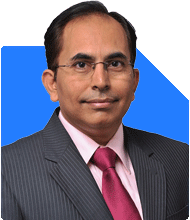Ramalingam Kalirajan |10874 Answers |Ask -Follow
Mutual Funds, Financial Planning Expert - Answered on Jul 05, 2024
He has an MBA in finance from the University of Madras and is a certified financial planner.
He is the director and chief financial planner at Holistic Investment, a Chennai-based firm that offers financial planning and wealth management advice.... more

Hello Sir, I am 33 years old. I have a corpus of 1.35cr. My monthly expenses are 30000 per month. I am assuming life expectancy of 90 years. How can I efficiently manage this corpus to withdraw 30000 per month so that it lasts(inflation adjusted) till I'm 90?
Understanding Your Financial Needs
Monthly Expenses and Inflation
You currently have monthly expenses of Rs 30,000. Assuming a life expectancy of 90 years, it’s crucial to factor in inflation. Over time, inflation will erode the purchasing power of your money. Let’s consider an average inflation rate of 6% per annum.
Longevity and Withdrawal Strategy
You’ll need your corpus to last for approximately 57 years. A sustainable withdrawal strategy, coupled with smart investments, will be key. The goal is to balance withdrawals and growth, ensuring your corpus outpaces inflation.
Investment Strategy: Diversification and Growth
Diversified Portfolio
A diversified portfolio will spread risk and provide a balanced approach to growth and stability. Consider the following components:
Equity Mutual Funds: These funds offer growth potential, which is essential to beat inflation. Opt for a mix of large-cap, mid-cap, and small-cap funds to balance risk and return. Actively managed funds can outperform index funds, especially in the long run.
Debt Mutual Funds: These funds provide stability and regular income. They are less volatile than equity funds and help preserve capital. Include a mix of short-term and long-term debt funds.
Hybrid Funds: These funds invest in both equity and debt, offering a balanced approach. They provide growth potential while mitigating risk.
Public Provident Fund (PPF): A long-term, risk-free investment with tax benefits. It provides a stable return and helps in maintaining a conservative portion of your portfolio.
Systematic Withdrawal Plan (SWP)
A Systematic Withdrawal Plan allows you to withdraw a fixed amount regularly from your investments. This strategy helps manage your monthly expenses while keeping the remaining corpus invested. It’s a disciplined approach to ensure your money lasts longer.
Balancing Risk and Return
Equity Funds for Growth
Equity funds are essential for growth. They come with higher risk but offer the potential for significant returns. Given your long-term horizon, the power of compounding will work in your favor. Over time, equity investments can outpace inflation and grow your corpus.
Debt Funds for Stability
Debt funds provide stability and preserve capital. They are less affected by market volatility and offer regular income. Including debt funds in your portfolio will balance the high-risk equity investments and ensure you have a stable income stream.
Hybrid Funds for Balance
Hybrid funds offer a mix of growth and stability. They invest in both equity and debt, providing a balanced approach. This diversification within a single fund can help manage risk and enhance returns.
Power of Compounding
Compounding: Your Best Friend
Compounding is the process where the returns on your investments generate their own returns. This exponential growth can significantly increase your corpus over time. The earlier you start and the longer you stay invested, the more powerful compounding becomes.
Staying Invested
To fully benefit from compounding, it’s crucial to stay invested for the long term. Avoid the temptation to withdraw large sums prematurely. Let your money grow and work for you.
Tax Efficiency and Planning
Tax-Advantaged Investments
Invest in tax-efficient instruments like PPF, Equity-Linked Savings Schemes (ELSS), and National Pension System (NPS). These options provide tax benefits under Section 80C and can reduce your taxable income.
Systematic Investment Plan (SIP)
A SIP in mutual funds not only helps in disciplined investing but also offers tax benefits. It spreads your investment over time, reducing the risk of market volatility and providing the advantage of rupee cost averaging.
Regular Monitoring and Rebalancing
Portfolio Reviews
Regularly review your portfolio to ensure it aligns with your goals. Market conditions change, and so do your financial needs. A Certified Financial Planner (CFP) can help you assess your investments and make necessary adjustments.
Rebalancing
Rebalance your portfolio periodically to maintain the desired asset allocation. This involves selling some investments that have performed well and buying those that haven’t, keeping your portfolio balanced.
Emergency Fund and Liquidity
Maintaining an Emergency Fund
An emergency fund is essential to cover unforeseen expenses without disrupting your investment strategy. Aim to have 6-12 months’ worth of expenses in a liquid and safe instrument, like a savings account or liquid mutual fund.
Ensuring Liquidity
Ensure that part of your investments is in liquid assets. This will allow you to withdraw money without penalties or losses when needed.
Risk Management and Insurance
Adequate Insurance Coverage
Having adequate insurance coverage is crucial to protect your corpus. Health insurance and term life insurance will safeguard you and your family from financial shocks.
Minimizing Unnecessary Risks
Avoid high-risk, speculative investments that promise quick returns. Stick to a well-thought-out strategy focused on long-term growth and stability.
Planning for Different Life Stages
Early Years (30s-40s)
Focus on growth-oriented investments like equity funds. Your risk tolerance is higher, and you have time to recover from market fluctuations.
Mid Years (40s-60s)
Gradually shift towards a more balanced portfolio. Increase allocation to debt funds for stability while still maintaining equity investments for growth.
Later Years (60s-90s)
Shift to a more conservative portfolio with a higher allocation to debt funds. Ensure regular income through systematic withdrawals and maintain liquidity for emergencies.
Seeking Professional Guidance
Certified Financial Planner (CFP)
A CFP can provide personalized advice tailored to your financial goals. They can help you navigate complex financial decisions and optimize your investment strategy.
Continuous Learning
Stay informed about financial markets and investment options. Continuous learning will empower you to make informed decisions and adapt to changing market conditions.
Final Insights
You’re on the right path with a corpus of Rs 1.35 crores at 33 years old. Managing this corpus to ensure it lasts until age 90 requires a well-diversified investment strategy, disciplined withdrawals, and regular monitoring.
By investing in a mix of equity, debt, and hybrid funds, leveraging the power of compounding, and maintaining tax efficiency, you can achieve your goal. Regular portfolio reviews and rebalancing, coupled with adequate insurance and an emergency fund, will further ensure financial stability.
Your commitment to a long-term investment horizon and disciplined approach will pay off. Stay focused, keep learning, and seek professional guidance when needed. You’re on track to achieving financial independence and ensuring your corpus lasts a lifetime.
Best Regards,
K. Ramalingam, MBA, CFP
Chief Financial Planner
www.holisticinvestment.in
You may like to see similar questions and answers below
Ramalingam Kalirajan |10874 Answers |Ask -Follow
Mutual Funds, Financial Planning Expert - Answered on Oct 24, 2024
Janak Patel |71 Answers |Ask -Follow
MF, PF Expert - Answered on Jun 05, 2025
Janak Patel |71 Answers |Ask -Follow
MF, PF Expert - Answered on Jun 05, 2025
Ramalingam Kalirajan |10874 Answers |Ask -Follow
Mutual Funds, Financial Planning Expert - Answered on Jul 30, 2025
Mayank Chandel |2569 Answers |Ask -Follow
IIT-JEE, NEET-UG, SAT, CLAT, CA, CS Exam Expert - Answered on Dec 08, 2025
Mayank Chandel |2569 Answers |Ask -Follow
IIT-JEE, NEET-UG, SAT, CLAT, CA, CS Exam Expert - Answered on Dec 08, 2025

Mayank Chandel |2569 Answers |Ask -Follow
IIT-JEE, NEET-UG, SAT, CLAT, CA, CS Exam Expert - Answered on Dec 08, 2025
Mayank Chandel |2569 Answers |Ask -Follow
IIT-JEE, NEET-UG, SAT, CLAT, CA, CS Exam Expert - Answered on Dec 08, 2025
Mayank Chandel |2569 Answers |Ask -Follow
IIT-JEE, NEET-UG, SAT, CLAT, CA, CS Exam Expert - Answered on Dec 08, 2025
Anu Krishna |1746 Answers |Ask -Follow
Relationships Expert, Mind Coach - Answered on Dec 08, 2025
Ramalingam Kalirajan |10874 Answers |Ask -Follow
Mutual Funds, Financial Planning Expert - Answered on Dec 08, 2025
Samraat Jadhav |2499 Answers |Ask -Follow
Stock Market Expert - Answered on Dec 08, 2025
Ramalingam Kalirajan |10874 Answers |Ask -Follow
Mutual Funds, Financial Planning Expert - Answered on Dec 08, 2025
Radheshyam Zanwar |6737 Answers |Ask -Follow
MHT-CET, IIT-JEE, NEET-UG Expert - Answered on Dec 08, 2025























